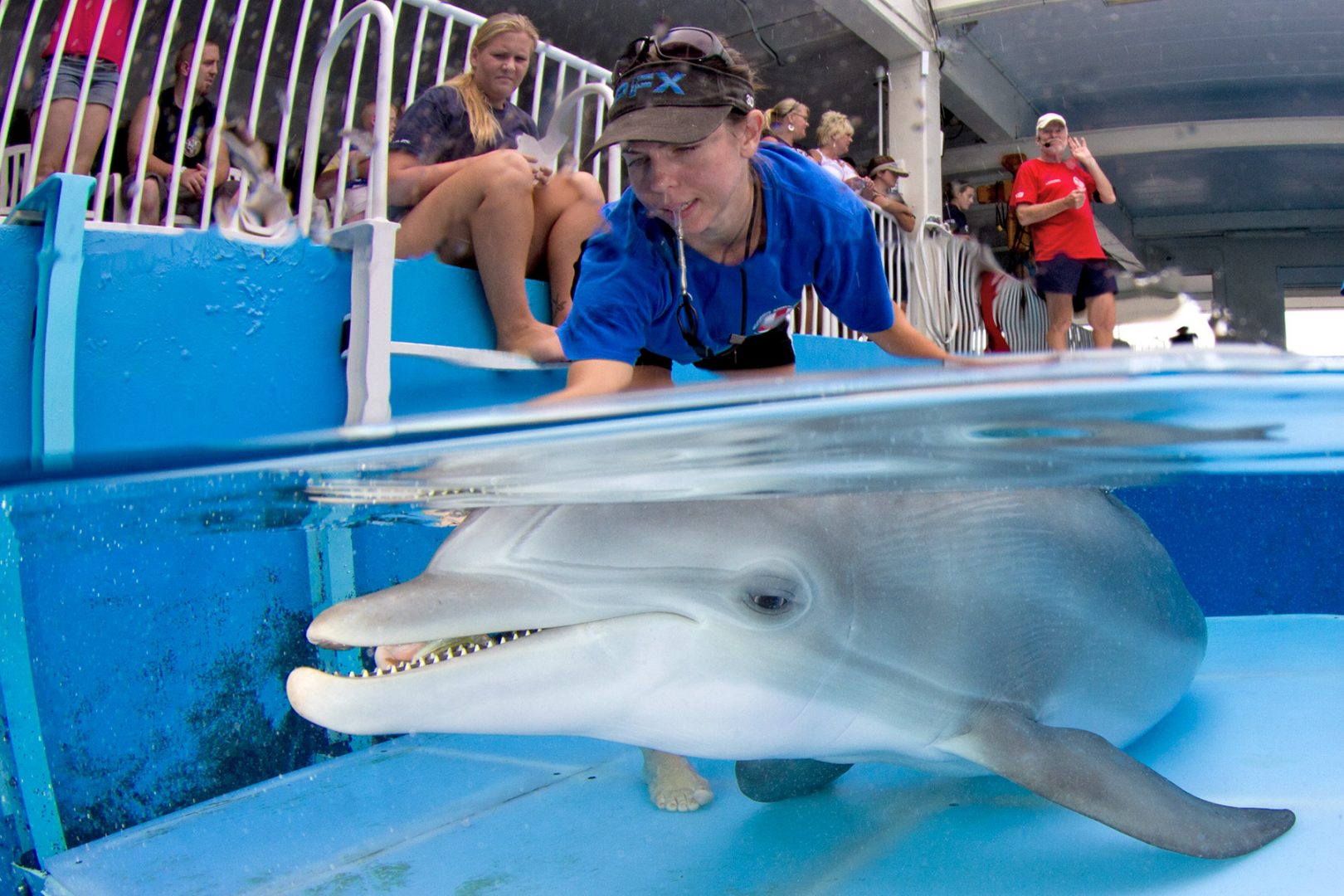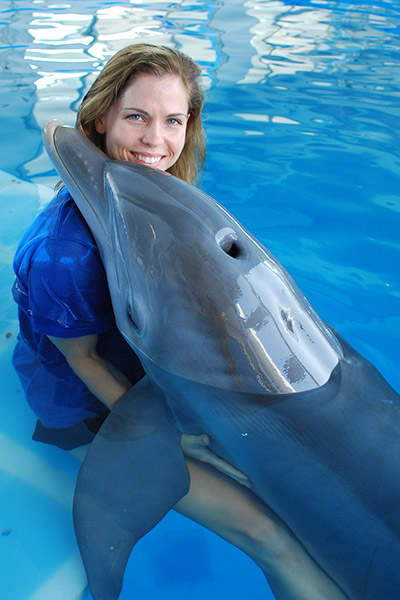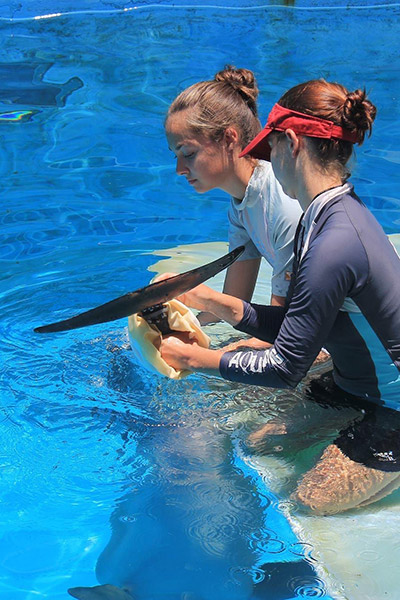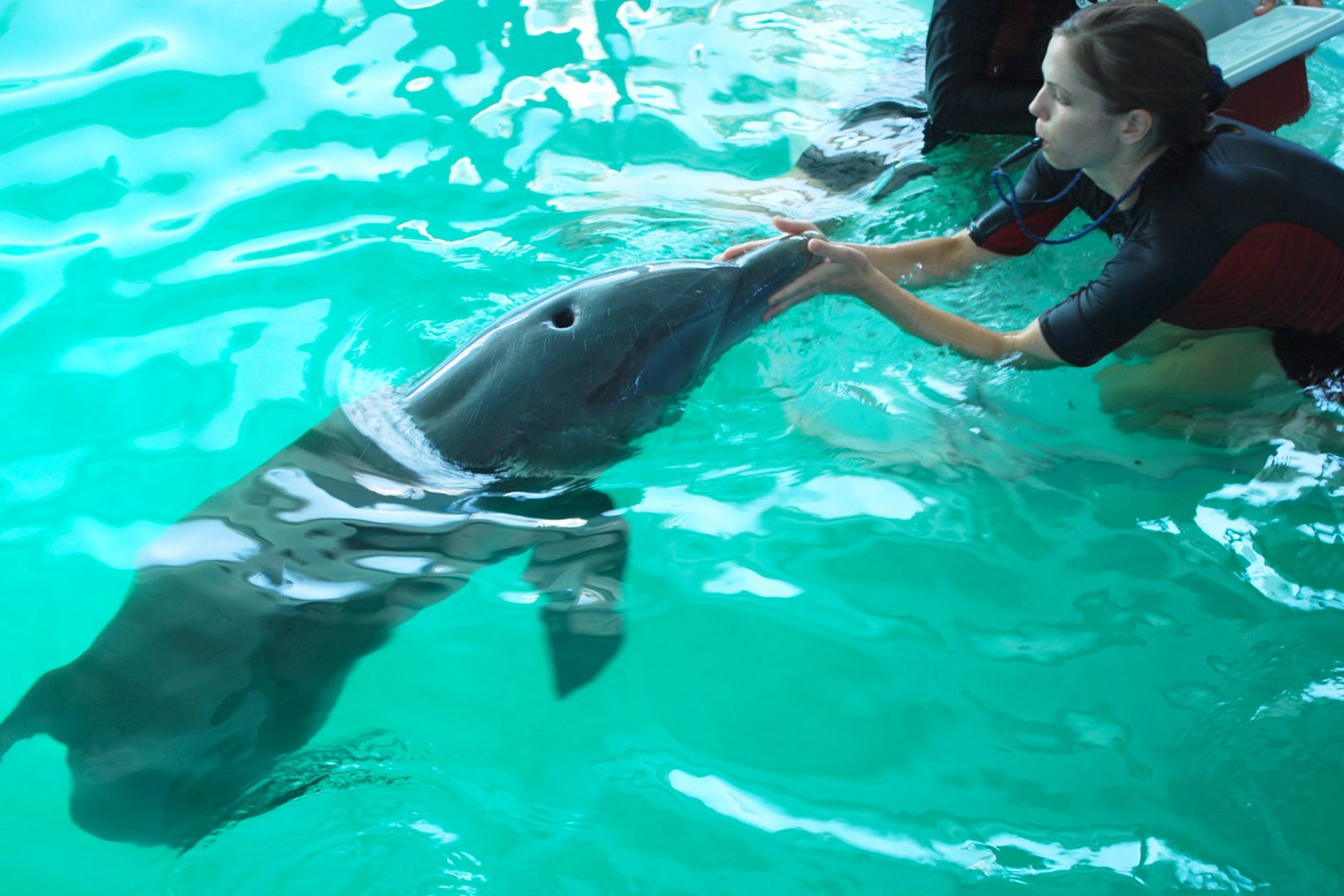
Abby Stone ’02 works with Winter the dolphin. Photos courtesy of Clearwater Marine Aquarium
Their journey together began on a cold, chaotic night. It was Dec. 10, 2005, and Abby Stone ’02 was working at the Clearwater Marine Aquarium (CMA) when a baby female bottlenose dolphin was brought to the facility.
A fisherman named Jim Savage had found her earlier that day gasping for air because a rope from a crab trap had entangled much of her body, including the inside of her mouth, her dorsal fin and her tail.
She weighed 68 pounds and was estimated to be about 2 months old. She was also completely exhausted and very near death.
What happened next is a story familiar to millions of people around the world, including most who live in the Tampa Bay area.
The dolphin was named Winter, and she was carefully nursed back to health, including being fitted two years after her rescue with a prosthetic tail. From her habitat at the CMA, she became an inspiration to just about everyone, especially those with physical disabilities. She was the subject of the 2009 children’s book Winter’s Tail and the star of the 2011 film Dolphin Tale and its 2014 sequel. Her Facebook page has 1.7 million likes.
Early last month, Winter became disinterested in food and staff noticed she wasn’t acting like her normal self. On the evening of Nov. 11, Winter died in the arms of her caregivers. A necropsy later revealed her cause of death was an intestinal torsion. She was 16.
Through all of this—from gently rocking Winter in a shallow aquarium pool that frantic first night, to the evening she died—was Abby Stone.
Stone started working at the CMA in 1996 as an animal care intern and now is Rescue Programs Manager and Stranding Coordinator for the aquarium. She recently recalled her journey with Winter and the extraordinary bond that can form between an animal and a human.
“When I first saw her,” Stone says, “there were a lot of concerns. She didn’t look good. Her overall color was normal, but her tail flukes lacked color due to necrosis. We hadn’t handled a case like that before because most animals with that type of entanglement would succumb to drowning.
“There was a lot unknown at the time, so we really focused on small goals like feeding her and getting her comfortable. We had people in the pool holding her and walking with her. We focused on her healthcare. She had to be on formula, so we wanted to make sure she was accepting a bottle. That was a big goal for us.”
As time went on and Winter’s caregivers realized she was doing well, Stone says, “We started to see her be more playful and interactive. All the things we wanted to see. Then we started looking long term. How were we going to be able to provide her with the exercise she needed?
“It’s pretty remarkable that she recovered from her injuries,” Stone adds. “Not only that, but she thrived. She had a lot of energy, was super curious and very interactive. She was limited, but we were encouraged by her behavior in general.”
After being fitted with the prosthetic tail in 2007, Stone says Winter became even more energetic and playful. Her connection with people also strengthened.
“The bond and the closeness with the people who cared for her [were] more than you’d expect,” Stone says. “It could be that Winter relied on people more than other dolphins. She was raised by people and not a dolphin mom. She was extremely cooperative and receptive to the things we asked of her.
“But if you wanted to be in her inner circle, you had to work for it,” Stone adds with a chuckle. “She wasn’t open to working with just anyone. She showed a preference for certain individuals, maybe a handful of people. But she was also very easy going. She liked to lounge with people, lay on your lap, be where you were.”
When Winter became ill and was showing signs of decline, Stone was right there with her. “There was a lot of anxiety, but you want to stay optimistic and focused in order to help the animal,” Stone says. “And when she died, it was a shock at first. Even if you know it might happen, it still sucks.

“But I would absolutely do it over again. I was blessed to have been part of her journey. It was a privilege for me to be there for her. It’s always worth doing. It’s like that old saying that it’s better to have loved and lost than never to have loved at all.
“I definitely have no regrets. You really have to open your heart to that animal, especially when you’re with her every day. She’s a part of your life. I’ve had other losses in my life. It’s similar to losing a loved one. It doesn’t matter whether it’s a person or a pet, it’s pretty much the same grieving process.
“And my memories of her are beautiful. I spent a lot of time thinking about that. I just reflected on the fact that we didn’t think she’d survive, and yet she lived 16 wonderful years and did remarkable things for conservation, for humans who related to her story. I just focused on all the good that came from her life.”
Stone’s work with Winter earned her a part in both movies and taught her many lessons. It also underscored the admiration of at least one Eckerd alumna who came after her. Katie Willgohs ’21, a psychology and animal studies graduate who now is the stewardship coordinator in Eckerd’s Advancement Office, says Stone has mentored her since they first met in 2012.
“I was a young girl with a dream of working with animals, so my parents surprised me with a trip to the Clearwater Marine Aquarium for my 13th birthday,” Willgohs explains. “I did the ‘Trainer for a Day’ encounter in which I got to shadow a trainer, and my animal interaction just so happened to be with Abby and Winter.
“My parents and I chatted with Abby afterward and learned that she [had] studied psychology at Eckerd. My mom immediately went online and looked at Eckerd, finding Professor Lauren Highfill and her comparative psychology lab, and I have been hooked ever since. I will always credit Abby for being the reason I went to Eckerd.”
Winter, Willgohs says, was like Stone’s child. Not only did Stone train Winter for the Dolphin Tale movies, but she was among the first who trained her to use her prosthetic tail. “Winter wouldn’t have been the dolphin she was without Abby, and I doubt she would’ve lived as long as she did without Abby.
“I know that Winter got Abby through some difficult times in her life,” Willgohs adds, “and vice versa.”

Katie Willgohs ’21 (left) and Abby Stone ’02 remove Winter’s prosthetic tail after a physical therapy session.













